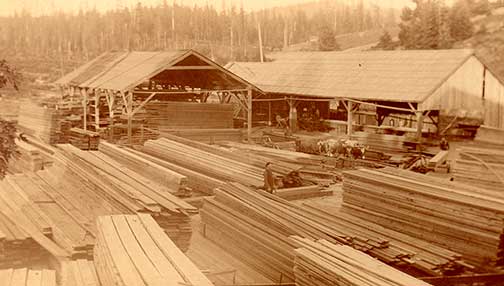 |
Previous Issues |
| Cedar Mill Community Website |
|
Search the Cedar Mill News: |
About The Cedar Mill News |
|
|||||||
| Volume 14, Issue 4 | April 2016 |
||||||
The Old Mill at Cedar Mill—1859-1892
|
||||
 |
| The old mill in 1883. "Linc" Young stands in the center. The road leading off to the upper right is probably McDaniel (now 119th). |
Power for operating the saw in the early years of the mill was furnished by a large “overshot” wheel (waterwheel), using the water from the creek (Cedar Mill Creek), which supplied water for the storage pond [the mill pond that can still be seen north of Cornell]. The water eventually fell over a natural waterfall, giving a 32-foot drop. The mill was a “muley,” i.e., the logs were guided by hand, a one-man operation, contrary to the rigid saw method with a saw in a frame, as commonly used in those days in small mills.
[Ed. Note: this seems to confirm our suspicion that the mill was actually located on the north side of Cornell at 119th, adjacent to the mill pond!]
When water was plentiful, the mill was kept busy cutting timber, mostly cedar (hence the name Cedar Mill), and occasionally cut logs hauled in from other vicinities, such as oak from the Bethany area. Many of the homes in the northeast section of Portland were built and shingled from the products of this mill. A wharf on Lake Michigan was built from oak sawn at this mill. When the water was low, activity was more or less confined to cutting and hauling logs from the timber nearby to be stored in the pond, awaiting more water power.
Logging was done by oxen, and it was no uncommon sight to see a three-yoke of oxen hitched to a drag of logs, destined for the storage pond. Also, in slack water periods, the millhands cut shingles with a froe (a wedge-shaped tool for cleaving), making an up-and-down chop from rounds of cedar logs.
For many years the mill products were hauled to Portland through the canyons by oxen, and later by horses. The original route to Portland was via the “planked” road (our Canyon Road of today), however, Cornell Road and Barnes Road were also used, and sections of those roads were also “planked.”
In the early days Barnes Road was known as the “Portland to Hillsboro” road, being named Barnes in later years. Cornell Road, from McDaniel Road [now 119th] junction, east to Balch Creek, Multnomah County, was not cut through until February 1868. This section was referred to as the “Cornell Gap.” Previous to 1868, Cornell Road turned north at this junction and went up in and around the hills, exiting at Balch Creek.
There have been many stories written about the old Mill, but the writer feels that this is authentic, having been taken from family biographies of those who owned and worked in the mill, together with the above-cited Washington County Deed Records and County Surveyor’s Records.
[*Hazel Young was the family historian for many years, and the mother of Bernie Young. This article was among a big box of historical documents donated to the Cedar Mill Historical Society—now a 501c(3) charitable organization—by Bernie’s widow, Mary Young of Cedar Mill. We can’t wait to share more of these treasures with you in the months to come!]
Transcribed by Elissa Ryan Morris.
![]()
Like us on Facebook for timely updates
Published monthly by Pioneer Marketing & Design
Publisher/Editor:Virginia Bruce
info@cedarmillnews.com
PO Box 91061
Portland, Oregon 97291
© 2016